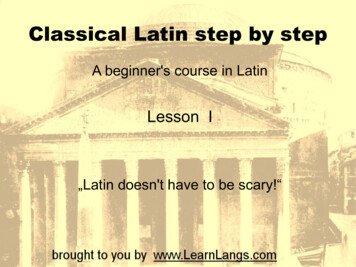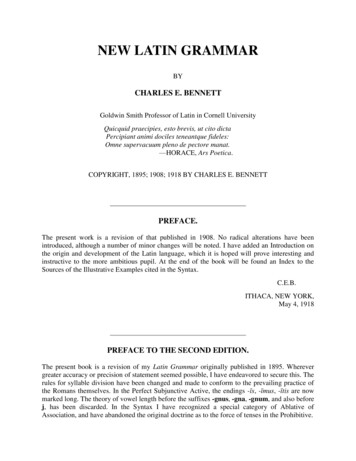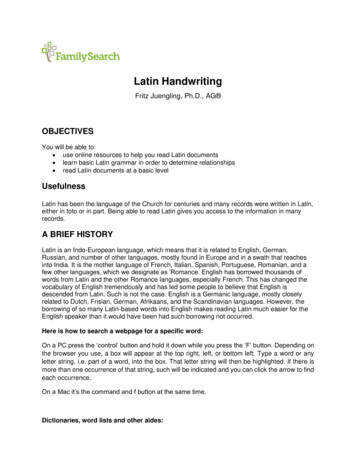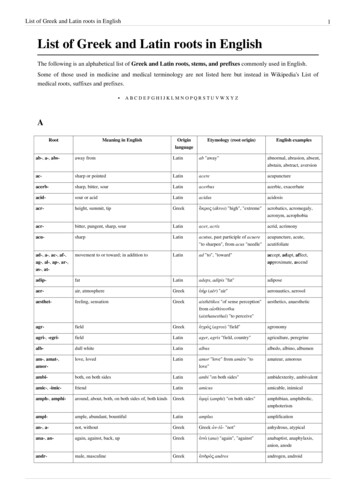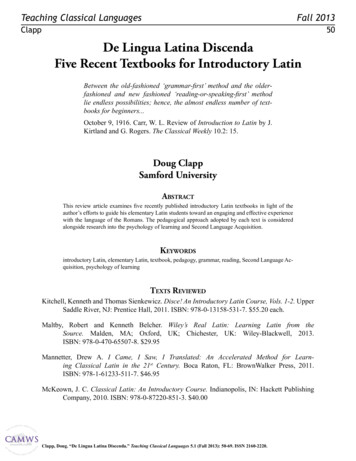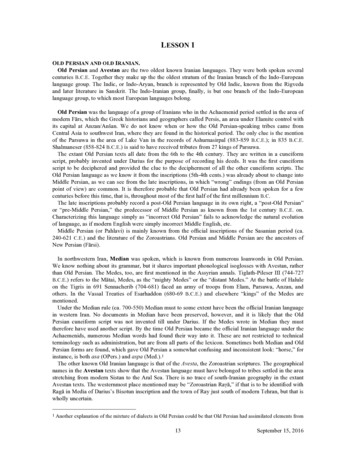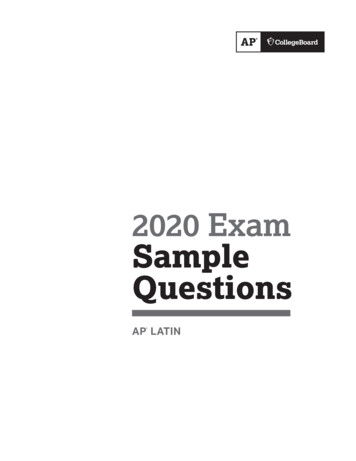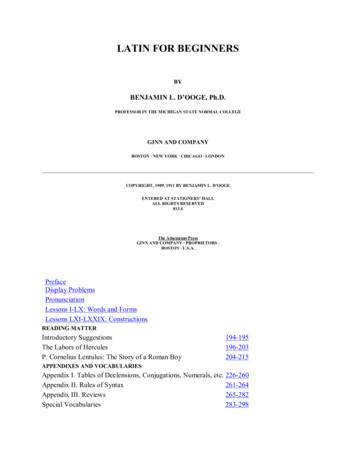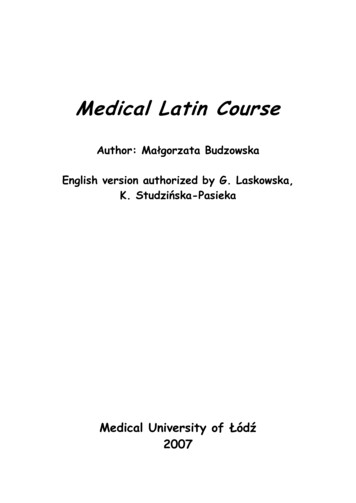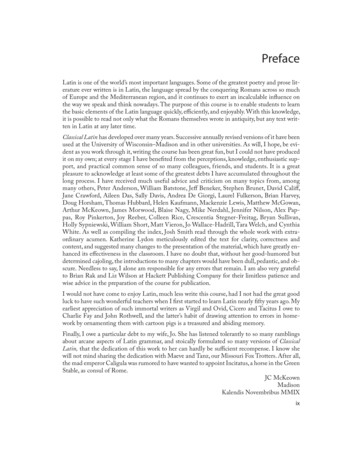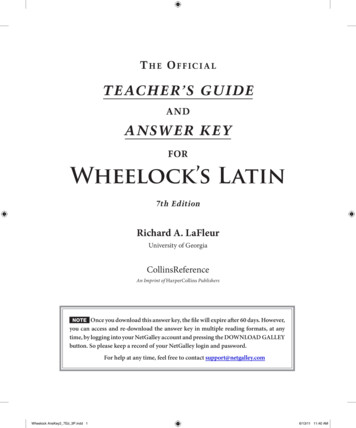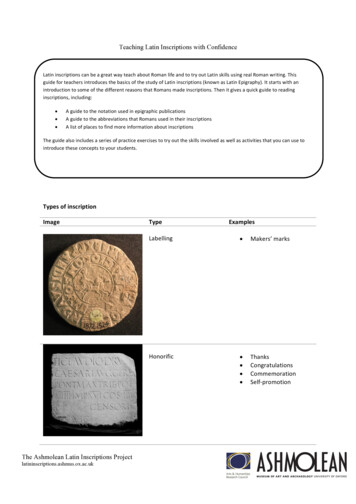
Transcription
Teaching Latin Inscriptions with ConfidenceLatin inscriptions can be a great way teach about Roman life and to try out Latin skills using real Roman writing. Thisguide for teachers introduces the basics of the study of Latin inscriptions (known as Latin Epigraphy). It starts with anintroduction to some of the different reasons that Romans made inscriptions. Then it gives a quick guide to readinginscriptions, including: A guide to the notation used in epigraphic publicationsA guide to the abbreviations that Romans used in their inscriptionsA list of places to find more information about inscriptionsThe guide also includes a series of practice exercises to try out the skills involved as well as activities that you can use tointroduce these concepts to your students.Types of inscriptionImageThe Ashmolean Latin Inscriptions esLabelling Makers’ marksHonorific ThanksCongratulationsCommemorationSelf-promotion
Votive Thanks to deityPromise to deityRequest to deityLegal Weights and MeasuresCitizenship decreesLawsDecreesFunerary EpitaphsColumbarium plaquesProperty markersAsh urnsGraffitiThe Ashmolean Latin Inscriptions Projectlatininscriptions.ashmus.ox.ac.uk
You can find out more about some of the different types of inscriptions, including rarer kinds likegold glass and sling bullets in the Ashmolean Latin Inscriptions Project’s Featured Objects eatured/To introduce students to the range of different kinds of Latin inscriptions, you can use the RomanWriting Matching Activity cards.Easy Epigraphy: decoding brackets and symbolsEpigraphic publications use shorthand to record what inscriptions say. Because small changes in thetext of Latin can make a big difference to what it means, it is important for editors to show whichletters are clear on the inscription and which have been supplied by their own interpretation.Brackets are used to mark off sections of text that have been subject to editorial intervention. Thetype of brackets shows what changes have been made.Symbol()[][[ ]](VAC.) { }Used forAn abbreviated word,which the editor haswritten out in fullLetters lost throughdamage, but suppliedby editorLetters erased inantiquity, but can stillbe read clearlyMarking a deliberatelyblank spaceCorrecting a mistakemade by the originalinscriberLetters carved in error,which the editor hasremoved Letters omitted inerror, which the editorhas added Damaged traces ofletters which cannotbe recognised; eachcross represents oneletter.ABCLetters read by aprevious editor;currently invisibleThe Ashmolean Latin Inscriptions n saysAVGThe epigrapher VXITMD (vac.) Mins t ruxit
Deciphering an inscriptionThis example shows epigraphic notation in i(berio) Claudio Drus[if(ilio)] / Caesari Aug(usto) Germ(anico) / pont(ifici) max(imo) trib(unicia) pot(estate) / VIIII imp(eratori) XVI co(n)s(uli) IIII / 5 p(atri) p(atriae) (vac.)censori / vic(us) [-]‘To Tiberius Claudius CaesarAugustus Germanicus, son ofDrusus, supreme pontiff, holderof tribunician power for the 9thtime, hailed victorious generalfor the 16th time, consul for the4th time, father of his county,censor. The [-] district (set �VIIII·IMP·XVI·COS·IIIIP·P·CENSORIVICTo practice these skills, try the DIY Edit your own Inscription activity in this pack.The Ashmolean Latin Inscriptions Projectlatininscriptions.ashmus.ox.ac.uk
Reading inscriptionsSpace was often at a premium on inscriptions, so Romans had their own shorthand for writing them.Sometimes words run into each other without spaces, so the first task is to identify the individualwords. Small dots (called interpuncts) often appear between words. Not all inscriptions have theseand sometimes they are used inconsistently, but they can be helpful in picking out individual words.Commonly used names, words and phrases were often abbreviated. Epigraphic publications (like theexample above) will often expand abbreviations for you. However, it is helpful to know the mostcommon abbreviations.First names DecimusQuintusCommon titlesAbbreviationPONT. MAX.TitlePontifex Maximus, Chief pontiffTRIB. POTtribunicia potestas, with tribunician powerIMP.ImperatorCOS.consul, the highest political officeP.P.pater patriae, ‘Father of the country’The Ashmolean Latin Inscriptions Projectlatininscriptions.ashmus.ox.ac.uk
Funerary formulaeAbbreviationD.M.Full phraseDis ManibusTranslationTo the gods belowFFilius/FiliaSon/daughterVix. Ann.MDVixit AnnosMensesDieslived for years months daysS.T.T.L.Sit Tibi Terra LevisB.M.Bene MerentiMay the earth lie lightly onyouWell deservingFFecitMade thisH.S.EHic Situs/Sita Estis buried hereV.A.P.Mvixit annos plus minusLived more or less yearsThe “Cracking Codes” PowerPoint and worksheet are designed to introduce these abbreviations andpractice reading real funerary inscriptions with Latin learners. The presentation notes include fulltranslations and point out interesting facts about these objects.The Ashmolean Latin Inscriptions Projectlatininscriptions.ashmus.ox.ac.uk
Reading a tombstoneRoman tombstones are often highly formulaic and (with a bit of practice) easy to read.To read a typical tombstone:1. Look for name(s) in the dative case. This is usually the person (or people) for whom thegravestone was erected. In the example above, the name is Decimus Aemilius Vitalis2. Look for name(s) in the nominative case. This is usually the person (or people) who set upthe gravestone. Sometimes the verb Fecit/Fecerunt is included to make this clear.In the example above, this phrase is Clodia Helice Mater Fecit:3. Look for any familiar formulae and abbreviations. In this case: Vixit annos dies (you can tell the difference between this and the D. that stands forDecimus in the first line by context)4. Translate any phrases that remain and put it all togetherThe full translation for the example above is “For Decimus Aemilius Vitalis. He lived for 25 years, 48days. Clodia Helice, his mother, set this up.”The Tombstones and the Dative Case worksheet and Cracking Codes presentation can be used tointroduce your students to reading funerary inscriptions.The Ashmolean Latin Inscriptions Projectlatininscriptions.ashmus.ox.ac.uk
Teaching with objectsLatin inscriptions are as important for what they tell us as objects as for the writing on them.Teaching with objects is most effective when it encourages learners to look closely at the objectsand think through what they can tell us.Drawing activities can be great for getting students to look closely at objects and ask more detailedquestions. Try: Sketching the object and annotating the sketch with things like size colour and personalimpressions. Describe what is being depicted in any images and make a clear transcription ofthe words.Observational drawing – looking closely and trying to represent the inscription as accuratelyas possible. To really focus on the object, you can try drawing without looking at the paperDrawing and filling in missing or broken parts (this can include imagining colours, since manyancient stone sculptures and inscriptions were brightly painted)Drawing is often best done while looking at the objects themselves in the museum. However, youcan experiment with working from images on the Ashmolean Latin Inscriptions catalogue.Some objects in the AshLI catalogue have been photographed using a process called RTI (you canfind them at: ns/rti/ ). This allows you to drag thelight source around and view the texture of the inscription. To view an RTI image, click on the “RTIimage” link for the object. Then click theicon to view full screen and theicon to move thelight source by clicking on the image and dragging the mouse. This should give a clear sense of thetexture of the object’s surface.Research activities are another good way to encourage detailed thinking about objects. Try: Asking students to do research from an information source with a strict time limit. Whatwere they able to learn in the time and what questions do they still have about the object?Debating the objects: imagine you are a museum curator and you can add one of theseobjects to your collection. Which one should it be and why? Think about what is moreimportant in a museum object: beauty, connections to famous people, showing the lives ofordinary people, how much money it is worth or something else entirely? Have a classdebate to decide between the most popular objects.Look at the people behind the objects and write a story from their perspective. What did theobject mean to them? Work in some facts from your research and feel free to invent details.Or imagine the life of the object itself. What would it say if it could talk? What kinds of thingshas it experienced?Two truths and a lie – Go round the class asking students to pick out some facts about theobject and try to fool everyone else by slipping in one plausible lie. Get the class to vote onwhich is the fib.Write their own museum label for the object – decide what facts are most important aboutthe object and how to capture people’s imagination in a small space.The Ashmolean Latin Inscriptions Projectlatininscriptions.ashmus.ox.ac.uk
Make a poster about your favourite object using eye-catching images and clear explanatorytext to help people understand it.Make connections between objects. Take a group of objects and sort them by the thingsthey have in common.Arrange the objects on a timeline or on a map. Think about how large the Roman empirewas and how long it lasted.The Ashmolean Latin Inscriptions catalogue pages offer detailed information about the objects.Catalogue pages are designed to be detailed enough for experts and professionals to use in theirresearch, but might be useful for practising the skills of skim reading and picking out the mostrelevant information.For slightly easier research material, there is a set of fact sheets about selected Ashmolean Latininscriptions included as part of this pack.Finding out more:The Ashmolean Latin Inscriptions Project (AshLI): Web catalogue and teacher resources: http://latininscriptions.ashmus.ox.ac.ukBlog: ns or search ‘Reading, Writing,Romans’Twitter:@AshmoleanLatinWarwick Epigraphy: Links to Inscription Collections and tter:@W EpigraphyRoman Inscriptions of Britain (RIB): http://romaninscriptionsofbritain.orgCurse Tablets of Roman Britain: http://curses.csad.ox.ac.uk/Letters from Hadrian’s Wall (Vindolanda): http://vindolanda.csad.ox.ac.uk/Alison Cooley, The Cambridge Manual of Latin Epigraphy (CUP 2012)The Ashmolean Latin Inscriptions Projectlatininscriptions.ashmus.ox.ac.uk
The Ashmolean Latin Inscriptions Project latininscriptions.ashmus.ox.ac.uk Reading a tombstone Roman tombstones are often highly formulaic and (with a bit of practice) easy to read. To read a typical tombstone: 1. Look for name(s) in the dative case. This is usually th
